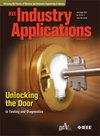Application of DC AF Incident Energy Reference Boundary Area Plots in TCCs Considering Input Parameter Variability
IF 4.5
2区 工程技术
Q2 ENGINEERING, ELECTRICAL & ELECTRONIC
引用次数: 0
Abstract
This work introduces the concept of dc C-areas in time-current characteristic plots (TCCs) for establishing a reference of dc arc-flash (dc AF) incident energy (IE) during the protection and coordination study. C-area plots represent a constant allowable incident energy for a piece of equipment while considering arc flash input data variability. This work introduces the C-area application for dc equipment. The dc C-area reference plots allow protection engineers to select overcurrent protective device settings in TCCs while keeping track of the allowable incident energy. This work explains the theory and derivation of the dc C-areas, the impact of the input parameter variability, and provides a detailed explanation of the data collection challenges for performing a dc arc-flash incident energy analysis. The dc C-area methods introduced in this paper are based on industry accepted dc arc-flash calculation equations, yet novel concepts in dc C-areas such as arc elongation and conductor erosion effects are discussed along with their effects. This paper also includes application examples of dc C-areas for battery energy storage systems (BESS) and photovoltaic (PV) systems equipment protection and coordination studies. The protection and coordination device setting selections made by means of dc C-areas are then compared to actual dc arc-flash incident energy calculations performed using commercially available power system analysis software to validate the methodology.考虑输入参数变异性的直流AF入射能量参考边界面积图在tcc中的应用
本文介绍了时间-电流特征图(tcc)中直流c区的概念,以便在保护和协调研究中建立直流电弧闪光(dc AF)入射能量(IE)的参考。c区图表示在考虑电弧闪光输入数据可变性的情况下,设备允许入射能量恒定。本文介绍了直流设备的c区应用。直流c区参考图允许保护工程师在tcc中选择过流保护装置设置,同时跟踪允许的入射能量。这项工作解释了直流c区理论和推导,输入参数可变性的影响,并提供了详细的解释数据收集挑战进行直流电弧闪光入射能量分析。本文介绍的直流电弧区方法是基于工业上公认的直流电弧闪蒸计算方程,但是讨论了直流电弧区的新概念,如电弧延伸和导体侵蚀效应及其影响。本文还包括直流c区在电池储能系统(BESS)和光伏系统(PV)设备保护与协调方面的应用实例。通过直流c区进行的保护和协调装置设置选择,然后与实际的直流电弧闪光入射能量计算进行比较,使用市售电力系统分析软件来验证该方法。
本文章由计算机程序翻译,如有差异,请以英文原文为准。
求助全文
约1分钟内获得全文
求助全文
来源期刊

IEEE Transactions on Industry Applications
工程技术-工程:电子与电气
CiteScore
9.90
自引率
9.10%
发文量
747
审稿时长
3.3 months
期刊介绍:
The scope of the IEEE Transactions on Industry Applications includes all scope items of the IEEE Industry Applications Society, that is, the advancement of the theory and practice of electrical and electronic engineering in the development, design, manufacture, and application of electrical systems, apparatus, devices, and controls to the processes and equipment of industry and commerce; the promotion of safe, reliable, and economic installations; industry leadership in energy conservation and environmental, health, and safety issues; the creation of voluntary engineering standards and recommended practices; and the professional development of its membership.
 求助内容:
求助内容: 应助结果提醒方式:
应助结果提醒方式:


